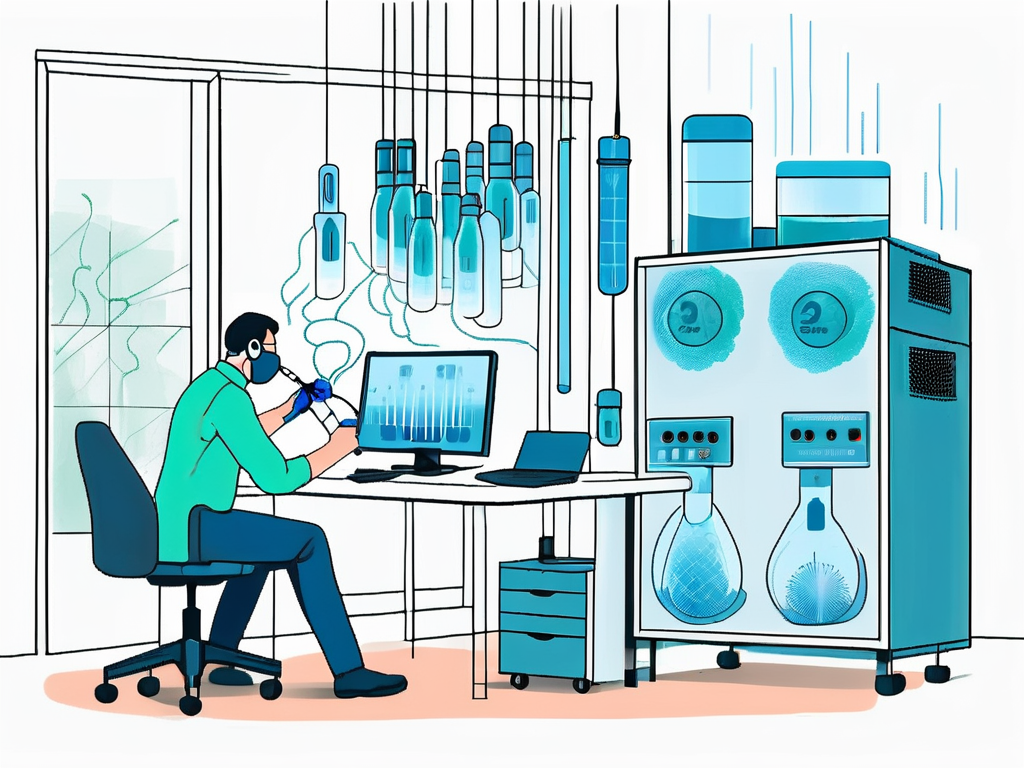Residential air quality testing is a crucial step in ensuring the health and well-being of you and your family. The air we breathe in our homes can have a significant impact on our health, and poor air quality can lead to various respiratory issues and other health risks. In this article, we will explore the importance of residential air quality testing and how it can improve the overall quality of your living environment.
Understanding Air Quality and Its Impact on Health
Air quality refers to the level of pollutants and contaminants present in the air we breathe. These pollutants can come from various sources, both indoors and outdoors. It is essential to maintain good air quality as it directly affects our health and can lead to numerous health problems if neglected.

Indoor air quality is equally important to consider, as we spend a significant amount of time inside our homes and workplaces. Common indoor pollutants include tobacco smoke, mold, pet dander, and volatile organic compounds (VOCs) emitted from household products. Proper ventilation and regular cleaning can help improve indoor air quality and reduce the risk of health issues.
Defining Air Quality
Air quality can be measured by assessing the concentration of pollutants such as particulate matter, volatile organic compounds (VOCs), carbon monoxide, nitrogen dioxide, and ozone. These pollutants can originate from sources like cooking, cleaning products, building materials, and outdoor air pollution.
It’s important to note that air quality can vary significantly based on location and time of day. Urban areas tend to have higher levels of pollution due to traffic emissions and industrial activities. Weather conditions, such as temperature inversions that trap pollutants close to the ground, can also worsen air quality. Monitoring air quality through local agencies or portable air quality monitors can help individuals make informed decisions to protect their health.
Health Risks Associated with Poor Air Quality
Poor air quality can have severe health effects, especially for vulnerable individuals such as children, the elderly, and people with respiratory conditions. Exposure to pollutants can lead to respiratory issues like asthma, allergies, bronchitis, and other respiratory infections. Long-term exposure to poor air quality has also been linked to cardiovascular disease, lung cancer, and other serious health problems.
It’s crucial for individuals to be aware of air quality alerts in their area and take precautions to reduce exposure on high pollution days. Simple steps like avoiding outdoor activities during peak pollution hours, using air purifiers indoors, and keeping windows closed on poor air quality days can help protect respiratory health. Additionally, advocating for policies that aim to reduce air pollution at a community and governmental level is essential for ensuring long-term improvements in air quality and public health.
The Role of Residential Air Quality Testing
Residential air quality testing plays a crucial role in identifying potential pollutants and contaminants in your home. By understanding the quality of the air you breathe indoors, you can take necessary measures to ensure a healthy living environment for yourself and your loved ones.
Indoor air quality can be influenced by a variety of factors, including inadequate ventilation, the presence of combustion sources, and the use of certain household products. Poor air quality can lead to a range of health issues, from respiratory problems to allergies and even more severe conditions over time. This is why regular air quality testing is essential for maintaining a safe and comfortable home environment.
Identifying Potential Air Pollutants in Homes
Residential air quality testing involves the detection and measurement of pollutants commonly found in homes. This includes assessing the levels of indoor allergens like dust mites, pet dander, pollen, and mold spores. Additionally, it examines the concentration of volatile organic compounds (VOCs) emitted by various household products and building materials.
It’s important to note that the sources of indoor air pollutants can vary, ranging from everyday activities such as cooking and cleaning to more hidden sources like asbestos insulation or formaldehyde-containing furniture. Understanding the specific pollutants present in your home can help you address them effectively and improve the overall air quality for a healthier living space.
The Process of Residential Air Quality Testing
The process of residential air quality testing typically involves the use of specialized equipment to collect air samples from different areas of your home. These samples are then analyzed to determine the levels of various pollutants. The testing process may also include monitoring for carbon monoxide, radon, and other harmful gases that can accumulate indoors.
Furthermore, air quality testing professionals may conduct a visual inspection of your home to identify potential sources of contamination, such as water damage, leaks, or poor ventilation systems. This comprehensive approach ensures that all aspects contributing to indoor air quality are thoroughly assessed, allowing for targeted solutions to be implemented for a cleaner and healthier living environment.
Benefits of Regular Air Quality Testing
Regular air quality testing offers several benefits and plays an integral role in maintaining a healthy living environment for you and your family.
Ensuring the air quality in your home is essential for the well-being of your family members. Regular air quality testing can provide valuable insights into the presence of pollutants such as mold, dust mites, pet dander, and volatile organic compounds (VOCs). These contaminants can have a significant impact on indoor air quality and may lead to various health issues if left unchecked.
Prevention of Health Issues
By identifying and addressing potential air pollutants, residential air quality testing can help prevent health issues associated with poor air quality. It allows you to take proactive measures to minimize exposure to harmful substances and reduce the risk of respiratory problems and other health conditions.
Furthermore, regular air quality testing can also detect the presence of carbon monoxide, a colorless and odorless gas that can be deadly if inhaled in high concentrations. Protecting your family from this silent killer is crucial, and routine testing can provide early warnings of any leaks or malfunctions in your home’s heating systems.
Improvement of Indoor Comfort
Residential air quality testing also helps improve the overall comfort of your home. By eliminating or reducing pollutants, you can enjoy cleaner air, which can enhance your indoor environment and make it more pleasant to live in. This is especially important for individuals with allergies or respiratory sensitivities.
In addition to health benefits, maintaining good indoor air quality through regular testing can also contribute to the longevity of your home’s furnishings and appliances. Airborne particles and pollutants can settle on surfaces, causing damage over time. By ensuring that the air in your home is clean and free of contaminants, you can protect your investments and maintain a healthier living space for years to come.
How to Improve Your Home’s Air Quality
In addition to regular air quality testing, there are several steps you can take to improve the air quality in your home.
Ensuring the air quality in your home is crucial for maintaining a healthy living environment. Poor air quality can lead to various health issues, including respiratory problems, allergies, and even long-term health effects. By taking proactive steps to improve your home’s air quality, you can create a safer and more comfortable space for you and your family.
Effective Ventilation Strategies
Proper ventilation is essential for maintaining good air quality. Ensure that your home is well-ventilated by opening windows, using exhaust fans in kitchens and bathrooms, and installing a whole-house ventilation system if necessary. Good airflow helps remove pollutants and brings in fresh outdoor air, improving overall air quality.
When it comes to ventilation, it’s not just about letting fresh air in. It’s also important to properly control indoor humidity levels to prevent mold growth and the proliferation of dust mites. Using a dehumidifier in damp areas of your home can help maintain optimal humidity levels, further enhancing your indoor air quality.
Use of Air Purifiers and Filters
Air purifiers and filters can help remove pollutants and allergens from your indoor air. Consider investing in a high-quality air purifier with a HEPA filter, which can effectively capture particles as small as 0.3 microns. Additionally, regularly clean and replace the filters in your HVAC system to ensure optimal performance.
In addition to using air purifiers, incorporating houseplants into your home decor can also help improve air quality. Certain plants, such as spider plants, peace lilies, and aloe vera, are known for their air-purifying properties and can help remove toxins from the air, creating a healthier indoor environment for you and your loved ones.
Choosing the Right Air Quality Testing Service
When it comes to residential air quality testing, selecting the right service provider is crucial. Here are some factors to consider:

Factors to Consider When Selecting a Service
- Experience and expertise in air quality testing
- Accreditation and certifications
- Use of reliable equipment and testing methods
- Comprehensive testing and analysis
- Clear and understandable testing reports
- Professionalism and excellent customer service
Understanding the Testing Report
A good air quality testing service will provide you with a detailed report of the findings, including the types and levels of pollutants detected. This report should be easy to understand and provide recommendations for improving your indoor air quality based on the results. If you have any questions or concerns about the report, don’t hesitate to reach out to the service provider for further clarification.
Conclusion
Residential air quality testing is a vital step in safeguarding the health and well-being of your household. By understanding the quality of the air you breathe indoors and taking necessary measures to improve it, you can create a healthier living environment. Regular air quality testing, coupled with effective ventilation strategies and the use of air purifiers, can significantly enhance the overall air quality in your home. So, prioritize the importance of residential air quality testing and take control of your indoor environment today!





